Foot tendonitis (tendinitis) can happen to anyone, and usually creates pain and tightness in the arch of your foot, your heel and even your toes. If you have tendonitis you'll usually feel pain located where your injury is and in the surrounding area. You may also suffer from swelling, heat sensation, redness and decreased function in your foot and/or ankle. Severe tendon pain (possibly from a tendon rupture or ruptured tendon) can result in an inability to walk or even place weight on the affected foot.
Tendonitis in the foot usually happens from overuse of the tendons from excessive walking, running, or adding to / increasing the amount of exercise or activity that you do. Improper stretching and poor form during activities may also cause foot tendonitis.
Anyone can suffer from tendonitis, but it's most common in adults due to degeneration of tissue as we age. Over time the tendons in the foot will wear down resulting in something called degeneration. This is where the fibers in your tendons will become more weak - it's just a natural process that happens as we age. Any abnormalities in your feet like higher or lower arches (flat foot) can result in foot tendonitis as well.
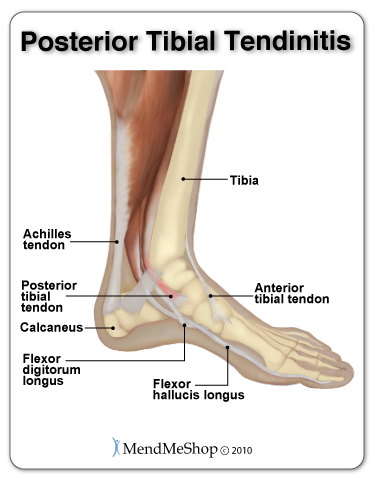

It may be hard to believe but any other injury or condition affecting your ankle, knee, hip or back that changes the way you walk (biomechanics or the way your foot hits the ground) in order to compensate for that injury can lead to foot tendonitis. This includes conditions like arthritis in your ankle or foot. If you have arthritis or osteoarthritis, this means that the bone and cartilage in your joint is already wearing away - it's a natural progression as we age. Arthritis can eventually lead to tendonitis as the joints in your feet and ankles become weaker.
Calcium deposits in and around the foot or ankle joint is another cause of foot tendonitis, and is often referred to as Calcific Tendonitis.
If you suffer from a foot tendon rupture (ruptured tendon) you might hear a sudden pop or experience severe pain immediately after you're injured. Tendon ruptures usually only happen from accidents or pre-disposed conditions that weaken the tendon - like repeated anti-inflammatory injections, calcium deposits (spurs) in and around your foot or ankle joints or other diseases (ie. gout). Tendon ruptures usually require surgery to re-attach the tendon to the bone, and if left untreated can result in permanent disability in your foot.
Foot tendonitis is only one of many conditions that can cause pain in your foot. Our feet are some of the most complicated joints in our bodies with 26 bones, 33 joints and more than 100 tendons, muscles and ligaments (reference: 1). Considering how complicated the foot joint is - it's easy to see how so many things can go wrong, leading to chronic foot pain and injuries. The fact that this joint is so complicated does make understanding your foot pain even more problematic.
Foot injuries are so common that 1 in 3 people over 65 have foot pain and 87% of people in the US will suffer from a foot injury or foot pain at some point in their lifetime (reference: 1).
A lot of foot injuries can create pain in the same area, and many foot injuries are caused by overuse, degeneration, improper technique / posture during activity and poor biomechanics. For example, you might have pain around the heel or ball your foot that could really mean you have a plantar fasciitis injury or sesamoiditis. In both of these examples the cause of your pain could be tendonitis in the tendon tissue, but you may also have some other underlying conditions such as a fracture in one of the bones in your foot, or a bone spur (calcium deposit).
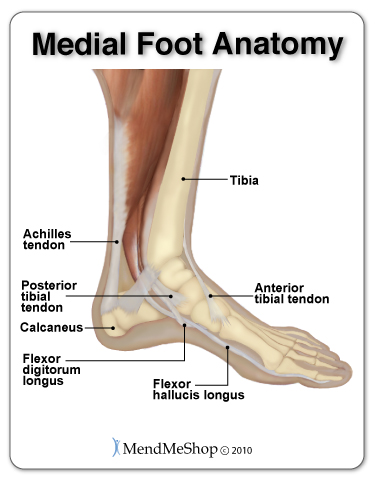
Some people will have other foot or ankle injuries, like Achilles Tendonitis, and think that they have foot tendonitis. When researching online or speaking to your doctor, you'll find that foot and ankle issues are often used to describe foot tendonitis interchangeably. It's easy to get many of these injuries mixed up because everything in the body is connected, and sometimes the pain from one injury will be felt nearby or in a different area of the body.
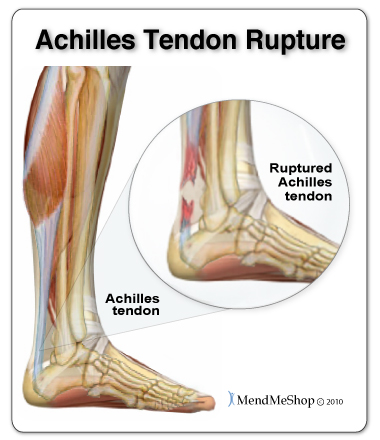
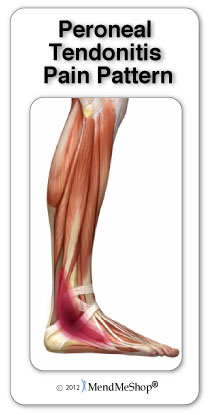
The most common forms of foot tendonitis are Posterior Tibial Tendonitis and Peroneal Tendonitis. Both of these types of tendonitis affect the sides of your foot. It's common to have one of these injuries and feel pain in the top of your foot or even in your ankle. Toe Deformities can sometimes also lead to chronic foot tendonitis pain.
If you have posterior tibial tendonitis you'll feel pain on the inner side of your foot. With this condition most pain is felt during the "push off" motion done with walking. If you have peroneal tendonitis you'll likely feel pain on the back and outer side of your foot and ankle. This injury will create radiating pain that you'll feel when standing and pushing off with your foot when walking.
When it comes to toes deformities, you'll definitely know when you have this injury because there will be a visual difference in the shape or bend of your toes. The 3 most common forms of foot deformities are hammer toe, mallet toe and claw toe. Along with these abnormalities, those who also suffer from bunions (hard bumps on the big toe joint) and calluses (thickened skin from friction or pressure) may also be at risk of getting foot tendonitis. In most cases bunions and calluses will develop from improperly fitted shoes - if your toes don't have enough space or the widest part of your foot (near your toes) rubs up against the inside of your shoes.
If you think that you're suffering from foot tendonitis and your mobility is steadily declining the first thing you need to do is see your doctor. Only your doctor can give you a proper diagnosis and from this, determine a course of proper treatment.
Constant re-injury needs to be avoided at all costs. Obviously, it delays the healing process, but what's worse is that every re-injury and additional healing cycle increases the amount of scar tissue that builds up in the area of your original foot tendonitis injury.
Scar tissue is hard, inflexible, and tough to get rid of. The more severe your foot tendonitis is, the more likely that this scar tissue will make your tendon much more prone to injury again later on. The more scar tissue that develops, the more you lose the range of motion in your foot and ankle.
Continuous re-injury and build-up of scar tissue while staying active means you'll have a greater chance of winding up with on-going pain, more tearing in your tendon, tendinosis (thickening of your tendon) or a full rupture.
If you have pain and inflammation in your foot or ankle, it's very important to heal your injury quickly and completely. You must avoid the build up of scar tissue. If you don't, your foot tendonitis injury may plague you forever. This is why it's so important to continuously use conservative treatment tools to heal any recurring tendon damage before it can build into something big. For any foot tendonitis sufferer, having the right tools means all the difference.
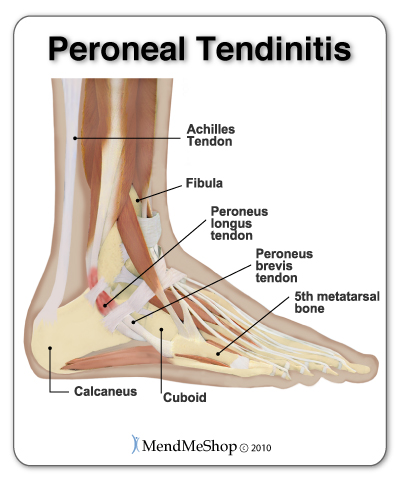
No one is immune to tendonitis but nearly everyone can easily reduce their risk of further re-injury with consistent conservative treatments. Mild and moderate cases of tendonitis / strained tendons are best treated with conservative home treatments. Severe injury to the tendon (ruptured tendons) will require surgery to re-attach the tendon to your bone so if you suspect that you've ruptured your tendon, be sure to speak with your doctor for suggested treatment.
The first step for conservative treatment of your foot tendonitis is to reduce the swelling to "open up" the area for more blood flow. Anyone in the health-care business knows that your blood supplies the oxygen and much needed nutrients required to heal foot tendonitis injuries. This is why for years, doctors, trainers, and other medical professionals have recommended RICE (Rest, Ice, Compression, Elevation) to treat the pain and swelling of fresh injuries, chronic pain, and after any re-injury.
This is important because once blood vessels are blocked or damaged, they can no longer carry oxygenated blood to your damaged tendon and tissues begin to break-down. Without cold compression, tissues break down further because they can't get the oxygen they need to survive. By limiting the amount of damage done to your tendons, you also limit the amount of healing that needs to occur. This is a very important step to heal acute or chronic tendon injuries faster and with less pain!
Once the swelling is gone, moving the tendon and applying a local circulatory stimulation device like the TShellz Wrap® is really what is needed for completing the recovery cycle. This is critical because tendons are known to receive very little natural blood flow and blood flow is really how your body is able to heal itself. When the tendon tissue is damaged, the already-reduced blood flow is decreased down to a trickle which is why movement is encouraged - it helps get blood flow to where it is needed.
Blood flow (healthy circulation) is an important part of natural tissue healing. Injured tendons take the nutrients available in local blood flow (like oxygen and healing agents) to get rid of any damaged tissue and start growing healthy tissue.
In some cases of acute tendonitis, the micro-tearing is located in an area known as the watershed zone.
The watershed zone is basically a part of the tendon that has the weakest amount of blood supply (even when it's completely healthy with no tears). This area usually gets blood supply from peripheral veins. This reduced blood supply makes the watershed zone an area of your tendon that's prone to injury and a poor healing response.
Many tendons in the body are known to have watershed zones that are prone to tendon tears. Some of the tendons that have a watershed zone include the Achilles tendon, the posterior tibial tendon in the foot / ankle, the rotator cuff (supraspinatus) tendon in your shoulder, the bicep and tricep tendons in your arm and the flexor tendons in your hand.
TShellz Wraps® contain a unique Carbon Fiber Energy Pad which is flexible and will shape to conform to your body. This Energy Pad emits a uniform wave of perfectly safe energy over its entire surface. This energy is absorbed by soft tissue in the treatment area, opening blood vessels, resulting in an increase in blood flow. Increased blood circulation is what your body needs to accelerate the healing of soft tissue and this is why we recommend the TShellz Wrap®.
The TShellz Wrap® is an FDA Registered Medical Device and is suitable for use in therapeutic clinics and FROM HOME. It is completely safe for people and patients to use for themselves.
The technology found in a TShellz Wrap® has been used for decades in the worlds of professional and amateur sports - a contributing factor as to why athletes seem to recover from injuries so quickly.
Have you ever wondered by an athlete can return to activity after 3 or 4 weeks following a soft tissue injury - while your average person takes much longer to return back to normal? The secret isn't really that much of a secret - it involves consistent treatments (meaning multiple times a day) using a treatment like the TShellz Wrap® to stimulate blood flow to the injured tissues. Most athletes have the luxury of using in-house facilities many times per day.
How many us can afford the time and money to visit a clinic multiple times a day? Very few indeed. This is how you can gain some of the advantages that athletes enjoy in their injury recovery - by using a device like the TShellz Wrap® two or three times a day on a consistent basis.
We believe the TShellz Wrap® to be one of the most effective home treatments to increase localized blood flow to soft tissue in and around the treatment area.
We can promise that you will receive a product that is designed to be safe and does what it is supposed to do... reduce pain (as stated in "Therapeutic Heat and Cold", 4th edition. - Ed. Justus F. Lehmann, M.D., Williams, and Wilkin) temporarily increase length & flexibility of soft tissue (as stated in "Therapeutic Heat and Cold", 4th edition. - Ed. Justus F. Lehmann, M.D., Williams, and Wilkin) and aid your body in recovering from tendon, muscle and other soft tissue injuries via enhanced blood flow.
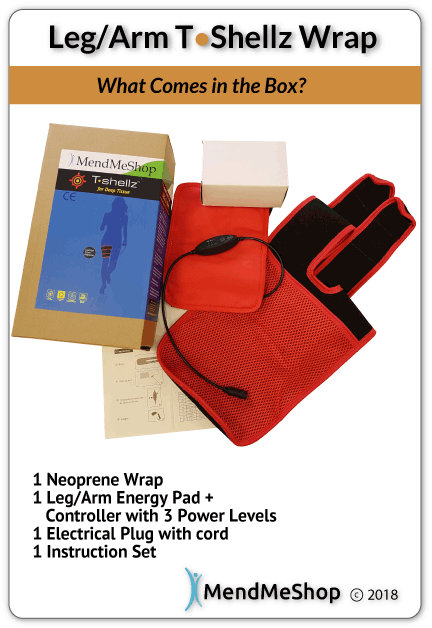
The unit plugs into a standard wall outlet to get its power. The nice thing about the power supply is that the same unit can be used in North America and overseas as well. It has the capability to operate between 110v and 230v.
The TShellz Wrap® has a special signal controller that can be set for 3 different power levels of application (3=High, 2=Medium, 1=Low). The cord is long enough that you can sit or lie comfortably and watch TV, read or surf the net while you're using it.
Treatments are max 30 minutes in duration and the device can be worn over clothing. This allows you to use the device at work, at home, or really anywhere you have access to an electrical outlet.
Click HERE to Go To Our Online Store If you have questions, call our office at 1-866-237-9608 (toll free continental US).
We believe the TShellz Wrap® to be one of the most effective treatments to stimulate blood flow to dense, injured tissues such as muscles, tendons, ligaments, and other similar tissues.
We can promise that you will receive a product that is designed to be safe and does what it is supposed to do...quickly relieve pain and aid in the recovery from tendon, muscle and other soft tissue injuries.
The unit plugs into a standard wall outlet to get its power. The nice thing about the power supply is that the same unit can be used in North America and overseas as well. It has the capability to operate between 110v and 230v. It has a special signal controller that can be set for 3 different power levels of application (3=High, 2=Medium, 1=Low). The cord is long so you can sit or lie comfortably and watch TV, read or surf the net while you're using it.
We recommend 5 to 10 minute treatments to start; the safety shutoff controller is set to max 30 minutes in duration. The device can be worn over clothing and allows you to use the device at work, at home, or really anywhere you have access to an electrical outlet.
The most common question we receive from individuals prior to purchasing is - how many times a day should I be using my wrap and when should I be using them? While treatment plans will differ for each individual and their specific injury, there are general guidelines that should be adhered to.
The TShellz Wrap® would then be used:
The final step in foot tendonitis recovery is stretching - this is a critical step for complete recovery from your injury!
PTs almost always prescribe gentle stretching for to deal with foot tendonitis, and they will typically prescribe a set of stretches for you to do at home. In a clinic, your PT will help you to perform these stretches and exercises if your foot hurts too much to do it on your own.
You'll find in most rehabilitation programs, stretching combined with conservative treatments at home will help to:
It's important to rest a partially torn or strained tendon because our natural healing process takes time to heal completely. If you don't rest your torn tendon, your acute tendonitis can quickly turn into a chronic tendonitis injury. To repair our damaged tendon tissue quickly, our bodies will use scar tissue to fill in the tears in the tendon. If you need to rest for an extended period of time and avoid certain activities that make your pain worse, you'll be more likely to develop massive amounts of this scar tissue as a temporary healing measure.
Scar tissue may plague you for weeks, months and maybe even years, depending on your level of activity and the amount of conservative treatments you have done during your rehabilitation. Scar tissue is a major problem, especially when it comes to re-injury of your tendon.
When dealing with scar tissue it's always important to:

Conservative treatment tools just like these have been used successfully by thousands of soft tissue injury sufferers - just like you.
We believe the use of TShellz® Circulatory Boost Wraps for boosting blood flow to soft tissue in the area of application is one of the most under-utilized home treatment options available on the market today. We have client after client that have tried many options out there and have been amazed at how effective and fast the TShellz Wrap treatment can relieve pain and increase blood flow in the treatment area.
With regular use of the TShellz® Circulatory Boost Wrap:
*Know that every personal soft tissue injury is unique and the TShellz Wrap may not work for everyone. This is why we offer a 60-day money back return on all our TShellz Wrap devices.
We all know that if the injury was healed, the pain would go away but what about the opposite situation? If the pain is gone, does that mean the injury is better? Unfortunately, this is not always true.
Too many people only focus on suppressing pain symptoms while providing less attention to the true healing aspects of the body. Experiencing less pain, while obviously a good short-term goal, does not equate to underlying healing. Scar tissue can remain for months after one gets to a point of being relatively pain-free. However, as long the weak and brittle scar tissue remains, you are susceptible to re-injury or re-aggravation. Certain motions or movements can cause the weaker tissue to easily tear - resulting in some reversal of the recovery up until that point.
This is why we recommend for people to continue with their doctor or therapist recommended exercises and to continue with mild treatments of the TShellz Wrap® for a period of time - to better ensure complete recovery.
Ongoing treatments to enhance circulation are intended to soothe, relax and promote healing of damaged soft tissue in the application area. T•Shellz treatment also results in the ability of soft tissue to extend further due to the effect of heat on soft tissue. The more extensible your tissues are, the less likely they are to strain or sprain.
People tell us all the time, "I was told that if I stay off my feet for a few weeks, my pain will disappear for good."
The truth is, tendonitis pain is usually a culmination of numerous factors, such as repetitive stress, poor posture, acute injuries, and overcompensation issues resulting from other muscle and soft tissue ailments.
It may take weeks or months for these pain triggers to surface. When they , however, merely resting will solve the underlying issues. You need to utilize actions and options that actually treat the source of the pain and help reverse the damage that has been done.
Resting has a role to play, but it is only one small factor in a recovery plan.
Product Advisors are available 9:00 am to 5:00 pm Eastern Standard Time Monday to Friday.
I want to learn more about Post-Surgery Recovery
I want to learn more about TShellz Wrap® Circulatory Boost
I want to learn more about Ice & Heat: Which Is Better For Treatment?
I want to learn more about Tendonitis Treatments
I want to learn more about Tendonitis Surgery
During your recovery, you will probably have to modify and/or eliminate any activities that cause pain or discomfort at the location of your soft tissue injury until the pain and inflammation settle. The more diligent you are with your treatment and rehabilitation, the faster you will see successful results!
Please be aware that this information is neither intended nor implied to be a substitute for professional medical advice. CALL YOUR HEALTHCARE PROVIDER IMMEDIATELY IF YOU THINK YOU MAY HAVE A MEDICAL EMERGENCY. Always seek the advice of your physician or other qualified health provider before using any of our outstanding products to make sure they are right for you and your condition or if you have any questions regarding a medical condition. Always see your doctor for a proper diagnosis as there are often many injuries and conditions (some very serious) that could be the cause of your pain.
© 2025 In.Genu Design Group, Inc. Contact Us